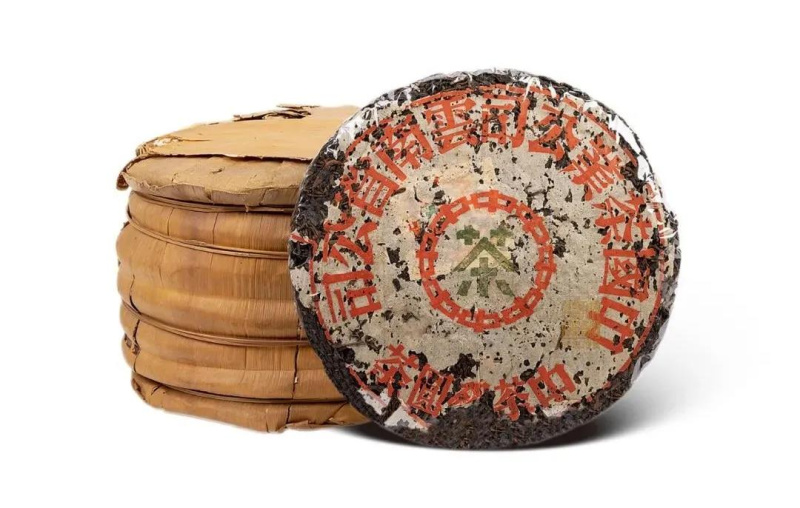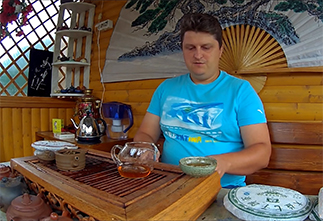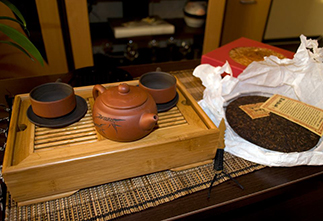Dry puer conveys fragrant aromas of dry wood and ripe nuts with a pleasant spicy note. After washing, against the background of spicy woody shades, delicate aromas of oriental halva and sweet spices are caught.
The taste of brewed puer is voluminous, thick and rich. Unobtrusive spicy notes, shades of damp wood, creamy tones prevail. By the 5th infusion, the taste is transformed into sweet and sour, filled with shades of ripe forest berries, mixed with a light nutty note. The infusion becomes very thick and dense like jelly.
The color of the infusion is dark chestnut, with an amber-red tint. Shu puerh "Minzhi Zhi Xing" can be brewed up to 10 times, smoothly changing the taste. It is best to brew this tea in a teapot made of Yixing clay, which will maximally reveal all the facets of the taste of aged shu puerh. To prepare the infusion, you will need 5-10 grams of dry tea leaves and a teapot with a capacity of 150-200 ml.
The aftertaste is long, very voluminous and enveloping due to the special chemical composition of the brewed tea.
Shu puer 2006 "Minzhi zhi xing" brand "Bajiaoting" perfectly tones and invigorates, noticeably sobers up, sets the right mood and lifts the spirits. This product of the well-known tea factory "Liming" will appeal to all lovers of black puer for its high quality, unique balanced taste and spiritual mood.
|
Name in Chinese
|
明日之星 |
|
Pinyin
|
mingrì zhī xīng |
|
English name
|
Star of Tomorrow |
|
Translation
|
Star of Tomorrow |
|
Country
|
China |
|
District
|
Xishuangbanna Dai Autonomous Prefecture |
|
Provinces
|
Yunnan (云南) |
|
Region
|
Menghai (勐海) |
|
Habitat
|
- |
|
Manufacturer
|
Лимин (黎明) |
|
Raw material production date
|
2006 |
|
Year of pressing
|
2006 |
|
Pressing form
|
Bing Cha (Cake Tea) |
|
Declared weight, g
|
357 |
|
Tea tree (bush) variety
|
Da Ye Zhong |
|
Size
|
20x20x2 |
|
Length, cm
|
20 |
|
Width, cm
|
20 |
- Комментарии
- Вконтакте
Pu-erh is one of the most unique types of tea, which only gets better with age. Many people, when they first encounter this tea, wondered: why is pu-erh more often found in pressed form (cakes, bricks, tochas), and not in loose form? The reasons for this are related to both history and the practical aspects of storing and fermenting tea. Despite modern technologies that allow the production of loose pu-erh, the shape of pressed cakes remains unchanged. And pu-erh is more often found on sale in pressed form, for example, in the form of cakes or bricks, and loose pu-erh is less common. We will talk about the reasons for pressing pu-erh into cakes in this article.
Puer is a unique Chinese tea that is distinguished by its depth of taste, complexity of aromas and versatility of aftertaste. Its taste characteristics are formed under the influence of many factors, from growing conditions to the brewing method. Let's look at the main ones.
The question often arises: how to brew puerh correctly? Sometimes the phrase "to get high" is added to it. Moreover, everyone has their own understanding of this phrase. Some mean vigor, and some - intoxication. So how to brew puerh tea correctly? Let's consider several options.
Traveling through the tea mountains, we found ourselves in another land of blue roofs - the village of Zhongcai, which is located in the Menghai district of Yunnan province. According to tradition, we were shown another local tea tree, which, according to the Chinese, is at least a million years old :) The village is very authentic, not designed for tourists, there are many wild pu-erhs there and, of course, we were warmly received. They treated us to local cuisine and tea. We also asked the residents about the prices of tea and how they have changed in recent years.
The tea ceremony occupies a special place in the centuries-old Eastern tradition. And although the essence of this phenomenon remains constant, the nature and external manifestations of the tea ceremony in different nations have their own national characteristics. In each Chinese province, the tea ceremony and the tea used in it are varied: for example, residents of the southern provinces prefer green tea, and residents of the northern provinces - red tea, in Fujian province they more often use Oolong tea, and in Yunnan province Puer tea is widely known.
































































































